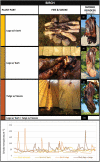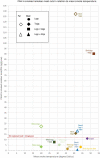Bridging traditional and scientific knowledge on reindeer meat smoking - a pilot study
- PMID: 35585785
- PMCID: PMC9122366
- DOI: 10.1080/22423982.2022.2073056
Bridging traditional and scientific knowledge on reindeer meat smoking - a pilot study
Abstract
Smoking reindeer meat in a traditional Sámi lávvu (tent) is a knowledgeable and long tradition for food preservation among Sámi reindeer herders. However, due to the formation of polycyclic aromatic hydrocarbons (PAH) during smoking, scientists associate smoked meat with human health risks. PAH contamination of smoked food depends on the smoking method, the temperature and the wood species. The smoking temperature and the PAH contaminations of Sámi traditional lávvu-smoked reindeer products yet remain uninvestigated. To remedy this knowledge gap, we developed a unique co-produced lávvu-laboratory pilot study for temperature measurements and PAH analysis of smoked reindeer meat with different Arctic wood species (willow, birch and juniper) and plant parts (logs and twigs). Our study confirms reindeer herders understanding, that birch wood, and especially birch twigs, generate higher smoking temperatures than willow. Except reindeer meat smoked with birch twigs, PAH levels of analysed reindeer meat cuts were lower than EU recommended maximum levels. However, all smoked reindeer fat samples showed much elevated PAH contaminations. Our results demonstrate the importance of co-production including both scientific and traditional knowledge in research for increased understanding of Indigenous peoples' traditional food smoking and to insure healthy traditional smoked Arctic products.
Keywords: Co-production; polycyclic aromatic hydrocarbons (PAH); reindeer husbandry; smoked reindeer meat; smoking temperature; traditional smoking; wood smoking.
Conflict of interest statement
No potential conflict of interest was reported by the author(s).
Figures









References
-
- Riddervold A. On the documentation of food conservation. In: Riddervold A, Andreas, editors. Food conservation - ethnological studies. London: Prospect Books; 1988: 210–218.
-
- Burgess P (Ed.) (2018). Indigenous youth, food knowledge and arctic change EALLU. International Centre for Reindeer Husbandry (ICR) Report 2017:1. Guovdageaidnu/Kautokeino, Norway.
-
- Krarup Hansen K, Moldenæs T, Mathiesen SD.. The knowledge that went up in smoke: reindeer herders’ traditional knowledge of smoked reindeer meat in literature. Polar Record. 2020;55(6):460–475.
-
- Smuk IA (2003). Dokumentasjon av produksjonsprosess på tørking og røyking av reinkjøtt. Sluttrapport for Teft – fadderstipend. Varangerbotn [Documentation of the production process for drying and smoking of reindeer meat. Final report for the Teft - sponsor scholarship. Varangerbotn] [Norwegian].
Publication types
MeSH terms
Substances
LinkOut - more resources
Full Text Sources
Miscellaneous
